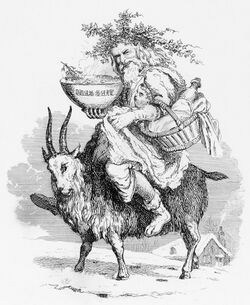Unsolved:Hold Nickar

Hold Nickar is the Scandinavian god of the winter solstice, related to Santa Claus. Legend has it that Hold Nickar galloped through the sky during the winter solstice, granting favors to his worshipers below.[1] "Nickar" was used for namesake, after Saint Nicholas.[2]
In Scandinavian legends, the god is known as Nickr or Nicor, a water demon or sea god, who is usually said to appear as a child with horse legs or an old man with long hair.[3][4]
Meaning
Hold Nickar is a corruption of Hjaldr Hnikar, one of the titles of the Norse god Odin that means "Inciter of Battles". The Odin "Hjaldr Hnikar" caused destruction through storms in the ocean. Both Nickar and Odin were depicted as old men with graying hair and beards (although the demon Nickar can also assume the appearance of a child with horse legs).[5]
"Hold Nickar" could be the origin of the name "Old Nick", a nickname for "Devil" in English.[6]
Legends
According to the oldest legends, Hold Nickar crossed the air in late December during the winter solstice, distributing blessings for his worshipers.
In various Scandinavian myths, the god or spirit of the month of December used to travel through his domains mounted on a he-goat (julbocken), while among the Germanic, he-goats were sacred animals of the god Thor, who possessed a flying chariot drawn by two goats, Tanngrisnir and Tanngnjóstr (Lightning and Thunder).[5]
The sensation of flying can arise during a psychedelic trance induced by fungi and mushrooms, such as Amanita muscaria. The consumption of such mushrooms was common among some ancient peoples, including the Sami of modern Finland and the Koyak tribes of the Russian steppes. As in other plants, which were consumed by humans who observed their effect on animals, especially reindeer. As the active ingredients of the fungus are not metabolized by the body and are eliminated in the urine, the consumption of foreign urine (including reindeer urine) became a habit of these semi-nomadic tribes, either in religious ceremonies or as a form of intoxication that preceded alcohol consumption by thousands of years. The shamans who collected such mushrooms, used to give them to the members of the tribe by throwing them through the opening for the exit of the smoke of the existing hearth in the center of the portable tents (and that, sometimes, served as an alternative entrance).[7]
Several of these pagan symbols were appropriated by Christianity and, throughout a centuries-long process, attributed to another, Saint Nicholas, a holy bishop who had lived in a region of today's Turkey in the 4th century. Saint Nicholas, finally, was largely supplanted in the 20th century by the image of the modern Anglo-Saxon Santa Claus (or Father Christmas), which, despite its connection to Coca-Cola commercial advertisements, still maintains the appearance, habits, mannerisms and companions of the old Scandinavian mushroom-picking shamans.[7][8]
In popular culture
Hold Nickar featured in the paranormal drama television series Supernatural's third season, eighth episode "A Very Supernatural Christmas".
References
- ↑ Brown, Jerry B.; Brown, Julie M. (in en). The Psychedelic Gospels: The Secret History of Hallucinogens in Christianity. Simon and Schuster. ISBN 978-1-62055-503-3. https://books.google.com/books?id=zmAoDwAAQBAJ&pg=PT63&dq=hold+nickar+santa&hl=en&newbks=1&newbks_redir=0&source=gb_mobile_search&sa=X&ved=2ahUKEwiSqrWEipTwAhVIXM0KHTuOAzkQ6AEwA3oECAAQAw.
- ↑ Lowe, Scott C. (in en). Christmas - Philosophy for Everyone: Better Than a Lump of Coal. John Wiley & Sons. ISBN 978-1-4443-4145-4. https://books.google.com/books?id=xvO8z83S16AC&pg=PT130&dq=hold+nickar&hl=en&sa=X&ved=2ahUKEwiI84uU85PwAhUHXM0KHbbRA9cQ6AEwCHoECAMQAw.
- ↑ Harland, John; Wilkinson, Thomas Turner (in en). Lancashire Folk-lore: Illustrative of the Superstitious Beliefs and Practices, Local Customs and Usages of the People of the County Palatine. F. Warne. https://books.google.com/books?id=snouAAAAYAAJ&pg=PA85&dq=hold+nickar&hl=en&sa=X&ved=2ahUKEwiI84uU85PwAhUHXM0KHbbRA9cQ6AEwAHoECAEQAw.
- ↑ Ayo, Nicholas (in en). St. Nicholas in America: Christmas Holy Day and Holiday. Corby Books. ISBN 978-0-9776458-1-7. https://books.google.com/books?id=kCXkUGdmLUcC&q=hold+nickar&dq=hold+nickar&hl=en&sa=X&ved=2ahUKEwiI84uU85PwAhUHXM0KHbbRA9cQ6AEwBXoECAkQAw.
- ↑ 5.0 5.1 "Santa Claus is Coming to Town". The Pagan Heart. http://thepaganheart.com/Issues/PastIssues/Dec04/MMM.html.
- ↑ "Just Who Is Santa Claus?". Vision. 6 October 2008. http://www.vision.org/visionmedia/article.aspx?id=4118.
- ↑ 7.0 7.1 "The Influence of Fly Agaric on the Iconography of Father Christmas". BBC. 21 December 2005. http://www.bbc.co.uk/dna/h2g2/A6084218.
- ↑ "Middle East Stage: Abeja Dispatch - February 23, 2000". http://www.worldtrek.org/odyssey/mideast/022300/022300abejastnick.html.

